Solana Price Prediction: Is SOL Coin a Good Investment?
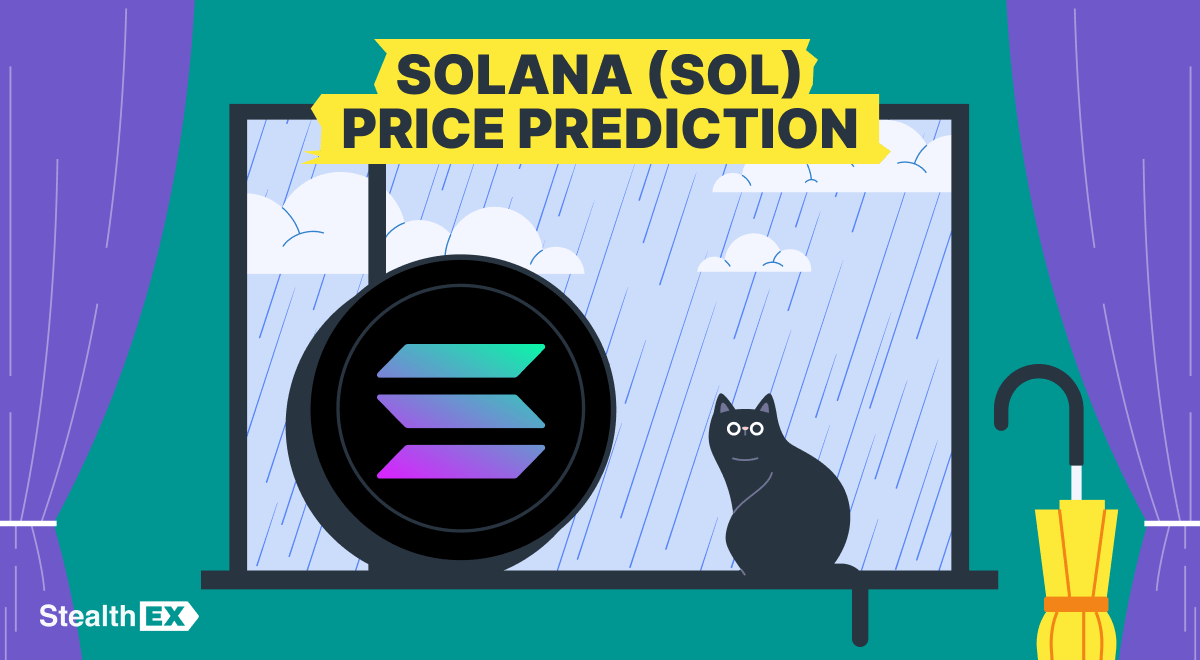
Solana (SOL) is a high-speed, low-cost blockchain platform designed to support decentralized applications and crypto-assets at scale. As the market started to recover, in the past month, the price of the Solana token went up to $187 (+75%) on May 14th from the previous low of $105.5 on April 9th, its minimum price this year, and continues to hover around $170-$185 per coin. In this article, we’ll lay down the latest Solana price prediction and delve into major factors that can impact the future of SOL. Today, we’ll break down the most recent Solana price prediction, examine historical performance trends, and explore the internal and external forces shaping its market value.
| Current SOL Price | SOL Prediction 2025 | SOL Price Prediction 2030 |
| $174 | $300 | $1,150 |
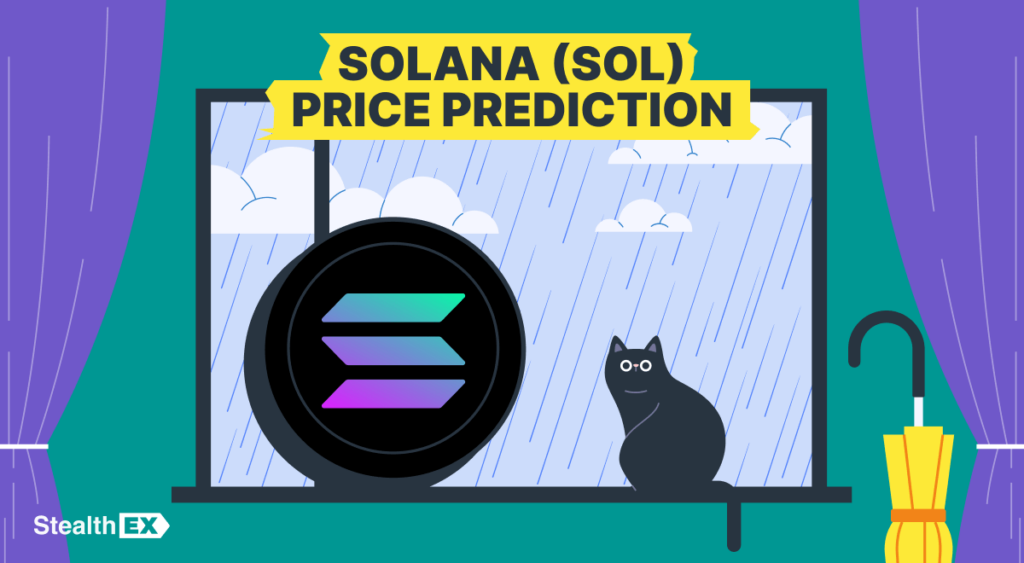
Article contents
- 1 Solana (SOL) Overview
- 2 SOL Price Chart
- 3 SOL Price History Highlights
- 4 Solana Price Prediction: 2025, 2026, 2030-2040
- 5 Solana (SOL) Price Prediction: What Do Experts Say?
- 6 SOL USDT Price Technical Analysis
- 7 What Does the SOL Price Depend On?
- 8 Is Solana a Good Investment?
- 9 Does Solana Coin Have a Future?
- 10 How Much Is 1 Solana Now?
- 11 How High Can Solana Realistically Go?
- 12 Can SOL Hit $5,000?
- 13 Will Solana Explode in 2025?
- 14 Which Coin Is Better than Solana?
- 15 Can Solana Beat Ethereum?
- 16 Is Solana Worth Buying?
- 17 Conclusion
- 18 Where to Buy Solana Coin?
- 19 How to Buy SOL Crypto: Quick-Step Guide
Solana (SOL) Overview
Solana is a high-performance blockchain platform designed for decentralized applications and cryptocurrencies. It distinguishes itself through its unique consensus mechanism, which combines Proof-of-Stake with a novel system called Proof-of-History (PoH). This hybrid approach allows Solana to process thousands of transactions per second, making it one of the fastest blockchain networks available. Its speed and efficiency make it an attractive option for developers looking to build scalable dApps, DeFi platforms, NFT marketplaces, and other blockchain-based services.
In addition to its performance advantages, Solana is known for its low transaction costs and robust infrastructure. The network supports smart contracts and is compatible with a wide range of development tools, fostering a vibrant ecosystem of applications and services. Solana’s architecture is designed to support long-term growth without compromising security or decentralization, which has positioned it as a competitive alternative to more established blockchains like Ethereum. Its ecosystem includes a wide array of tools, wallets, and exchanges, contributing to its growing popularity among users and developers alike.
SOL Price Statistics
| Current Price | $174 |
| Market Cap | $90,486,319,000 |
| Volume (24h) | $3,076,907,657 |
| Market Rank | #6 |
| Circulating Supply | 520,405,100 SOL |
| Total Supply | 601,680,899 SOL |
| 1 Month High / Low | $187.28 / $140.71 |
| All-Time High | $294.33 Jan 19, 2025 |
Solana is an open-source blockchain platform created in 2017 by former Qualcomm executive Anatoly Yakovenko. Anatoly formerly worked at Dropbox and Qualcomm and specialized in developing compression techniques and distributed systems. The Solana blockchain was introduced during the 2017 initial coin offering boom, with the main network officially launched in 2020 after multiple phases of testnet releases.
Solana Features
SOL has introduced a number of features to the crypto space, including:
- Scalability: Solana is made to handle thousands of transactions per second, and fees for both developers and users remain less than $0.0025.
- Proof-of-History (PoH): A distinctive feature of Solana, PoH is a cryptographic clock that timestamps transactions, enabling greater efficiency and order without the need for extensive communication between nodes.
- Energy-efficient: Solana’s network and other innovations minimize its impact on the environment. Each Solana transaction uses about the same energy as a few Google searches.
- Low transaction fees: Solana maintains minimal transaction costs, often fractions of a cent, making it suitable for high-frequency and microtransactions.
- Decentralization: The Solana network is validated by thousands of nodes that operate independently of each other, ensuring users’ data remains secure and censorship resistant.
- Ecosystem and developer tools: A rich suite of tools and resources, including SDKs, APIs, and documentation, supports a thriving ecosystem of DeFi apps, NFT platforms, and Web3 projects.
- Validator network: A large and growing network of independent validators secures the chain, enhancing its decentralization and resistance to censorship.
- Interoperability: Solana is designed to work with other blockchains, providing more opportunities for users to interact with other blockchains and expand Solana’s functionality.
- Speed: Solana has block times of 400 milliseconds – and as hardware gets faster, so will the network.
SOL Price Chart
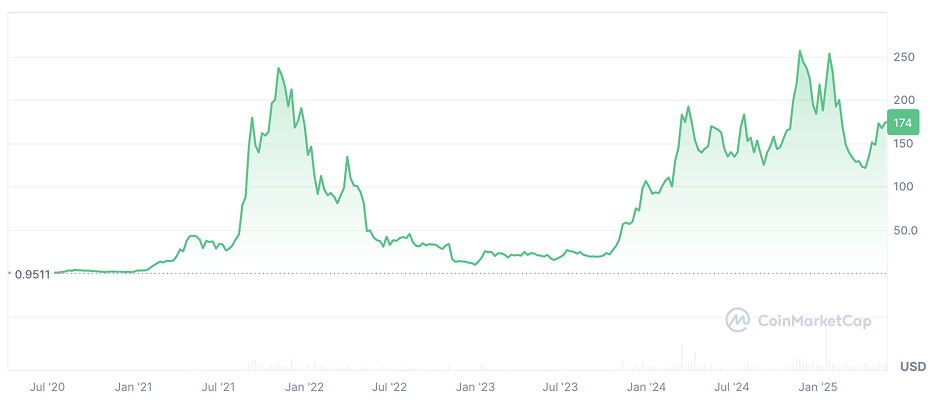
CoinMarketCap, May 26, 2025
SOL Price History Highlights
- 2020: Solana was launched in March 2020, and in April SOL hit $0.74. Solana saw a sharp decline in price in May 2020, to $0.55. In August, Solana’s price rose to $4.
- 2021: SOL had a very optimistic start to 2021; April saw SOL continue its strong bullish run, rising to $43 before dropping to $26 in May. In November, it reached a peak of $236.
- 2022: 2022 has not been a good year for Solana, with the coin falling from $170 to $9.8.
- 2023: At the end of 2023, Solana skyrocketed to $106.
- 2024: The bullish trends on the market continued to bring new price levels, and in November 2024 SOL spiked at $256.5.
- 2025: In January of 2025 Solana hit its all-time high of $294.3 and later plummeted to $120 range. At the moment, it hovers in the $170 – $180 price range.
Solana Price Prediction: 2025, 2026, 2030-2040
| Year | Minimum Price | Maximum Price | Average Price | Price Change |
| 2025 | $160.8 | $414.7 | $300 | +70% |
| 2026 | $305 | $506 | $400 | +130% |
| 2030 | $772 | $1,543 | $1,150 | +560% |
| 2040 | $2,663 | $51,238 | $27,000 | +15,400% |
Solana Price Prediction 2025
DigitalCoinPrice crypto experts suggest that in 2025 SOL coin’s price can hit $394.18 (+120%) at its peak, while at its minimum it can cost no less than $160.82 (-10%).
PricePrediction analysts think that in 2025, SOL token will cost no more than $213.68 (+20%) per coin at its lowest point. According to them, it will also cost no less than $254.49 (+40%).
Telegaon crypto analysts believe that in 2026 Solana crypto will cost a minimum of $265.51 (+50%), or it can hit $414.68 (+130%).
SOL Price Prediction 2026
DigitalCoinPrice experts are of the opinion that in 20265 SOL crypto will rise in price quite moderately: it’s expected to cost $385.11 (+115%) at its minimum, while at its peak SOL will rise to $452.38 (+150%).
PricePrediction analysts state that in 2026 Solana token will continue gradually increasing in price: it will hit $305.15 (+70%) at its lowest mark. It can also reach a maximum of $374.89 (+110%) at its peak.
Experts at Telegaon believe that in 2026 Solana crypto will cost a minimum of $415.12 (+130%), or it can hit $506.39 (+180%).
Solana Price Prediction 2030
DigitalCoinPrice analysts believe that by 2030, SOL token will rise to a maximum level of $982.61 (+450%), while it will also cost no less than $850.5 (+375%).
According to PricePrediction, by 2030 SOL crypto will hit $1,263 (+600%) at its minimum price, while at its peak it can go over $1,500 and hit $1,543 (+760%).
Telegaon predictions estimate that in 2030 Solana can hit $854.18 (+375%) at its peak. At its lowest point, it will cost no more than $772.13 (+330%) per coin.
Solana Price Prediction 2040
According to PricePrediction forecasts, in 2040 $SOL is going to hit $31,336 (+17,400%) at its low or reach a whopping $51,238 (+28,500%) at its peak.
According to Telegaon, in 2040 SOL coin’s price will cost no less than $2,663.19 (+1,400%) or it can go to $3,567.89 (+1,900%).
Solana (SOL) Price Prediction: What Do Experts Say?
Solana has been gaining momentum as one of the most efficient and scalable blockchain platforms, and upcoming network upgrades are only strengthening its position. Among the most anticipated changes is the Alpenglow update, a significant improvement designed to enhance Solana’s speed, stability, and capacity, especially during periods of high demand.
With Alpenglow, Solana will replace its existing data consensus system between nodes with a newer, faster mechanism. This upgrade is expected to allow blocks of transactions to be confirmed in just 100–150 milliseconds, making the network nearly instantaneous in response time. In addition, Solana is optimizing its internal data transmission processes to reduce the load on the computers (validators) that maintain the network, making the entire ecosystem more efficient and resilient.
Experts believe these improvements could be a catalyst for further growth in SOL’s price. By significantly boosting network performance, Solana is positioning itself to handle more decentralized applications, users, and trading volume: factors that tend to attract both retail and institutional investors. As a result, price predictions for SOL soon are increasingly bullish, with some analysts forecasting strong upward momentum as technical upgrades like Alpenglow roll out. Various experts have various opinions about how successful Solana will be. For instance, CoinLore experts believe that in 2030, the blockchain will continue developing, and $SOL will hit a peak price of $665.
SOL USDT Price Technical Analysis
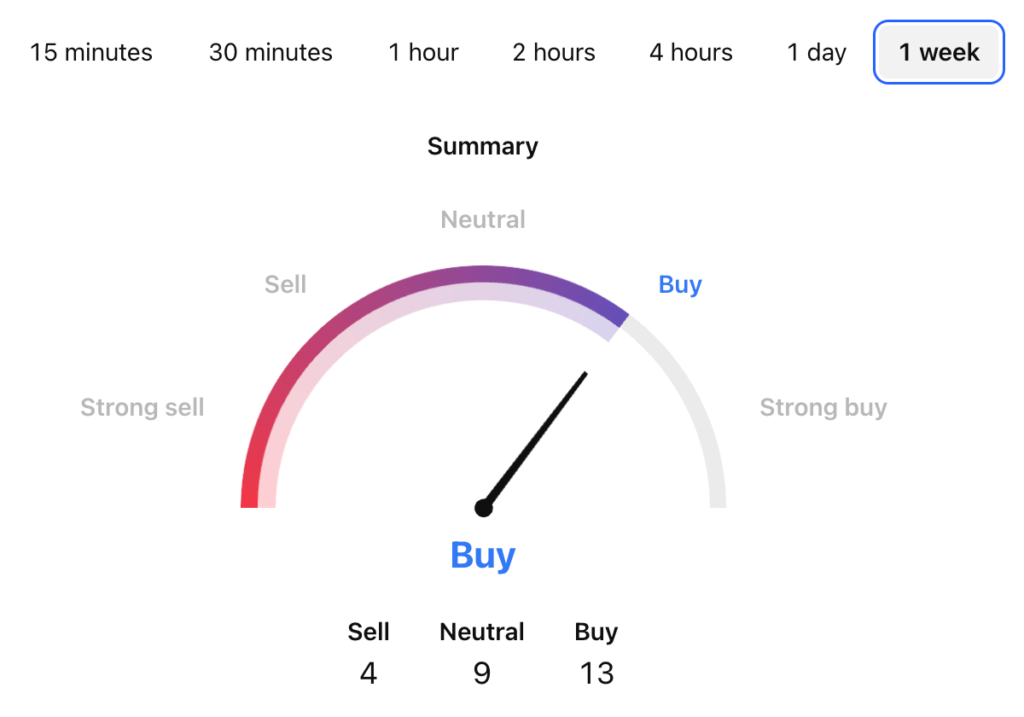
Tradingview, May 26, 2025
Now that we’ve seen possible price predictions for the Solana coin, let’s find out a bit more about the factors that can influence its price.
What Does the SOL Price Depend On?
The price of SOL is influenced by a mix of technical, economic, and market-specific factors. One of the most critical elements is network performance: speed, scalability, and uptime. As Solana continues to roll out upgrades like the Alpenglow update, which dramatically improves transaction finality and system efficiency, investor confidence in the network tends to grow, often leading to increased demand and higher prices.
Another key factor is ecosystem activity. This includes the number of active users and the total value locked (TVL) in Solana-based platforms. Additionally, market sentiment and macroeconomic trends play a significant role. Positive news (such as the launch of a Solana ETF, growing institutional adoption, or partnerships) can drive speculative interest. Conversely, broader crypto market downturns or regulatory uncertainty can cause price drops. Lastly, tokenomics, including SOL supply unlocks and staking incentives, influence circulating supply and investor behavior, further impacting price dynamics.
Risks and Opportunities
Solana presents a range of compelling opportunities for both developers and investors. Its core strength lies in its high throughput, low fees, and rapidly evolving ecosystem, which positions it as a strong alternative to other smart contract platforms like Ethereum. With the rollout of the Alpenglow update, Solana aims to significantly boost transaction speed and network reliability, making it more attractive for decentralized applications, high-frequency trading platforms, and gaming projects. Institutional interest is also on the rise, as shown by ETF filings and growing venture capital investment in Solana-based projects. These developments could increase SOL’s adoption and drive its long-term value.
Despite its potential, Solana also faces notable risks. The network has experienced multiple outages in the past, raising concerns about its reliability and decentralization. While technical updates like Alpenglow aim to address this, any future instability could harm user trust and investor confidence. Additionally, Solana operates in a highly competitive and fast-changing environment, with other Layer-1 blockchains continually improving. Regulatory pressure is another factor, especially in major markets like the U.S., where unclear legal frameworks around crypto assets could impact SOL’s accessibility and adoption. Finally, token unlocks and inflationary pressures from staking rewards may affect SOL’s price stability in the short to medium term.
Is Solana a Good Investment?
Solana shows strong potential for future growth, driven by its advanced technology, impressive scalability, and rapidly growing ecosystem. Its capability to handle thousands of transactions per second (far surpassing Ethereum’s throughput) makes it an appealing choice for applications that demand high performance. The network’s increasing adoption is further supported by partnerships with major projects and integrations across various industries. For investors with a high risk appetite and a long-term investment strategy, Solana could be a promising opportunity. Still, it’s important to consider the associated risks, such as occasional network outages, regulatory uncertainties, and overall market volatility.
How Does SOL Crypto Work?
Solana operates using a unique hybrid consensus model that combines Proof-of-History (PoH) with Proof-of-Stake (PoS). PoH provides a cryptographic timestamp to transactions, allowing validators to process them in order without having to communicate constantly, which significantly boosts speed. This enables Solana to handle thousands of transactions per second with minimal fees. SOL, the native cryptocurrency, is used for transaction fees, staking, and governance, helping secure the network and incentivize participation.
Does Solana Coin Have a Future?
Yes, Solana coin likely has a future, especially if it continues to build on its current strengths. Its high throughput, low fees, and innovative PoH mechanism position it as a strong competitor in the blockchain space, particularly for applications like DeFi, NFTs, and Web3 platforms that require speed and scalability. Its growing ecosystem and partnerships with major projects indicate increasing adoption.
What Happens to Solana in the Future? (Alpenglow)
Solana’s future looks promising, especially with the introduction of the Alpenglow upgrade. Alpenglow is a significant consensus overhaul aimed at enhancing the network’s performance and scalability. This upgrade is expected to increase transaction throughput, reduce latency, and improve overall network reliability. By implementing Alpenglow, Solana aims to solidify its position as a leading blockchain platform, capable of supporting a wide range of decentralized applications and services. The Alpenglow upgrade is part of Solana’s broader strategy to continue innovating and expanding its ecosystem in the coming years.
What Is Solana Alpenglow Upgrade?
Solana’s Alpenglow upgrade represents a significant evolution in the network’s consensus mechanism, aiming to enhance scalability, reduce latency, and improve overall performance. This overhaul is designed to address the complexities and limitations of the existing PoH and Tower BFT systems, which have faced challenges in terms of complexity and latency. By streamlining these processes, Alpenglow seeks to facilitate faster and more efficient transaction processing, enabling Solana to handle a higher volume of transactions per second.
How Much Is 1 Solana Now?
At the moment, 1 Solana costs around $174.
How High Can Solana Realistically Go?
If Solana overcomes its network reliability issues and continues expanding its ecosystem, it could realistically achieve valuations between $500 and $1,000, driven by increased adoption and demand for its token. In an optimistic scenario where Solana becomes one of the dominant platforms for blockchain applications, SOL could potentially surpass $1,000 or higher, rivaling Ethereum’s market capitalization if blockchain technology gains widespread adoption.
Can SOL Reach $500?
It’s a possibility. Solana’s high-speed, low-cost transaction model positions it as a strong competitor to Ethereum for decentralized applications. If Solana captures a significant share of the blockchain market, its valuation could rise, enabling it to approach $500. In addition, Solana’s rapid growth in DeFi, NFTs, gaming, and Web3 applications increases demand for SOL. As more developers and users adopt Solana’s blockchain, the value of SOL could rise significantly.
Can Solana Hit $1,000?
SOL reaching $1,000 is possible but highly ambitious, requiring massive adoption, continued technological upgrades like the Alpenglow consensus overhaul, and strong investor confidence. It’s not impossible, but it requires time and development.
Can SOL Hit $2,000?
SOL hitting $2,000 is an extremely ambitious target that would require transformative growth across multiple fronts: mainstream blockchain adoption, dominant market share in DeFi and Web3, flawless network performance, and sustained investor demand. For now, $2,000 remains a speculative long-shot rather than a realistic short- or mid-term expectation.
Can SOL Hit $5,000?
Because of its developing ecosystem and superior technology, some crypto analysts think Solana might reach $5,000 or perhaps more in the years to come. For instance, Telegaon expects Solana to hit $5,360 on average in 2034.
Can Solana Hit 10K?
Solana hitting $10,000 is extremely unlikely under current or foreseeable market conditions. At that price, Solana’s market capitalization would soar into the multi-trillion-dollar range, surpassing the total market cap of the entire cryptocurrency industry today, and rivaling the valuation of the world’s largest corporations like Apple or Microsoft. While not mathematically impossible, it’s a highly speculative, near-impossible scenario based on today’s fundamentals and realistic projections.
Can Solana Hit $100,000 Ever?
Solana hitting $100,000 is extremely improbable, even in the distant future. Achieving such a price would require Solana to not only dominate blockchain technology, but also completely replace traditional financial systems, have widespread adoption across all industries, and achieve massive growth in both blockchain usage and global demand. While the future of crypto and blockchain is uncertain, hitting $100,000 would require an unprecedented level of growth and adoption, making it a highly speculative and unrealistic scenario in the foreseeable future.
Will Solana Explode in 2025?
Predicting whether Solana will explode in 2025 is speculative, but there are several factors that could influence its potential for significant growth, including the Alpenglow update and its increased adoption. However, many experts are optimistic. For instance, Telegaon experts think that in 2025 Solana will reach a peak price level of $414.68.
How Much Will 1 Solana Be Worth in 2030?
PricePrediction believes that in 2030 SOL coin will reach a maximum of $1,540.
How High Can Solana Go in 10 Years?
Telegaon analysts think that in 10 years Solana will hit a maximum of $1,950.
How Much Will Solana Cost in 2040?
According to PricePrediction forecasts, in 2040 Solana will peak at $51,000.
What Is Solana Price Prediction for 2050?
PricePrediction experts think that in 2050 Solana will go as high as $91,000.
Which Coin Is Better than Solana?
The ‘better’ coin than Solana depends on your specific needs. Ethereum dominates with its large ecosystem, robust security, and strong developer support, making it ideal for complex decentralized applications, though it comes with higher fees. Avalanche competes with Solana in scalability and interoperability, while Binance Smart Chain offers low transaction costs and broad adoption, albeit with more centralization. Polkadot and Cosmos lead in interoperability, connecting blockchains seamlessly, while Cardano focuses on decentralization and research-backed development. While Solana excels in speed and cost-efficiency, it faces network reliability challenges. Each coin shines in different aspects, so the best choice ultimately depends on your goals and use cases.
Can Solana Beat Ethereum?
Solana has the potential to surpass Ethereum in certain areas, such as transaction speed, cost efficiency, and niche markets like gaming and high-frequency DeFi applications. However, Ethereum’s vast ecosystem, decentralization, and established trust give it a strong advantage in maintaining its dominance. Rather than overtaking Ethereum, Solana is more likely to coexist as a complementary platform, excelling in specific use cases while Ethereum continues to be the go-to choice for larger, more complex applications.
Can I Convert SOL to ETH?
Absolutely! All you need to do is visit StealthEX, a non-custodial exchange, and do a quick swap. You don’t need to create an account or go through a lengthy verification process.
Which Is Better: Solana or Cardano?
Solana may be better than Cardano for use cases that prioritize speed, scalability, and low fees, especially in DeFi, gaming, and NFTs, due to its high throughput and growing ecosystem. However, Cardano excels in security, decentralization, and sustainability, with a research-driven approach and a methodical, long-term vision that prioritizes stability and peer-reviewed development. While Solana is more suited for high-frequency, cost-effective applications, Cardano appeals to those who value academic rigor, energy efficiency, and a cautious approach to blockchain innovation. Which is ‘better’ depends on whether you prioritize performance or security and decentralization.
Solana vs. Bitcoin: Which Is Better?
The choice between Solana and Bitcoin depends on the use case. Bitcoin is the first and most established cryptocurrency, widely seen as a store of value and a hedge against inflation, with strong security and decentralization. However, it has slower transaction speeds and higher fees compared to newer blockchains. Solana, on the other hand, offers much faster transaction speeds, lower fees, and high scalability, making it ideal for dApps, DeFi, and gaming. While Solana is more efficient in terms of speed and cost, it is still relatively young and faces challenges with network reliability. If you’re looking for a long-term store of value, Bitcoin remains the safer bet, but if you’re more focused on speed, scalability, and modern blockchain use cases, Solana could be the better choice.
Is Solana Better than Polkadot?
Solana excels in speed and cost-efficiency, with its high transaction throughput and low fees, making it ideal for applications like DeFi, NFTs, and gaming that need to handle large volumes of transactions quickly. It’s also a more established platform in terms of performance. However, Polkadot stands out with its focus on interoperability, enabling different blockchains to communicate and share information seamlessly. It allows for the creation of customized, interconnected blockchains (parachains), which can be a major advantage for complex, multi-chain ecosystems. Polkadot’s focus is more on creating a network of blockchains rather than just scalability or high-speed transactions. If you need speed and low fees, Solana may be the better choice. But if your goal is to build or connect multiple blockchains with cross-chain communication, Polkadot offers a unique advantage. Both are strong, but the right choice depends on your specific needs and use case.
Who Is Solana’s New Competitor?
Solana faces emerging competition from several blockchain projects, each offering unique capabilities. Sui Network stands out with its high performance, surpassing Solana’s throughput with a theoretical 297,000 transactions per second. Lightchain AI integrates artificial intelligence with blockchain for scalable decentralized apps, while Rexas Finance focuses on asset tokenization, offering a new approach by creating tokens backed by physical assets. Additionally, DTX Exchange combines centralized and decentralized exchange features, providing a comprehensive platform with high-speed transactions. These projects, each targeting different niches, position themselves as strong competitors to Solana in the rapidly evolving blockchain ecosystem.
Why Is Solana the Best?
Solana is considered one of the best blockchains due to its high speed and scalability, processing up to 65,000 transactions per second with low transaction fees, making it ideal for dApps, DeFi, and NFTs. Its growing ecosystem and strong developer community make it a popular choice for building blockchain solutions. Despite challenges with network reliability and decentralization, Solana’s performance, speed, and cost-efficiency position it as a top contender in the blockchain space.
Is Solana Worth Buying?
Solana could be worth buying for those seeking exposure to a high-speed, low-fee blockchain with strong scalability and a growing ecosystem in sectors like DeFi, NFTs, and gaming. Its ability to process 65,000 transactions per second and its increasing number of dApps make it an attractive investment. However, potential buyers should consider risks such as network reliability issues, competition from other blockchains, and price volatility. Solana offers strong potential for growth, but it’s a high-risk investment, so thorough research and careful consideration of your risk tolerance are essential before investing.
Conclusion
Solana continues to prove itself as one of the most innovative and resilient players in the blockchain space. With its unmatched speed, low transaction costs, and a growing ecosystem of decentralized applications, it stands well-positioned to meet the demands of a rapidly evolving Web3 landscape. Upcoming upgrades like the Alpenglow update show a clear commitment to solving past issues and preparing the network for even greater scalability and reliability. While challenges remain, the strong developer community, increasing institutional interest, and continuous technical improvements suggest a bright future for SOL. For those looking ahead, Solana offers not just a cryptocurrency but a powerful platform with the potential to shape the future of decentralized technology.
Where to Buy Solana Coin?
StealthEX is here to help you buy SOL coin if you’re looking for a way to invest in this cryptocurrency. You can buy SOL privately and without the need to sign up for the service. StealthEX crypto collection has more than 1500 different coins and you can do wallet-to-wallet transfers instantly and problem-free.
How to Buy SOL Crypto: Quick-Step Guide
Just go to StealthEX and follow these easy steps:
- Choose the pair and the amount you want to exchange — for instance, ETH to SOL.
- Press the “Start exchange” button.
- Provide the recipient address to transfer your crypto to.
- Process the transaction.
- Receive your crypto coins.
Follow us on Medium, X, Telegram, YouTube, and Publish0x to stay updated about the latest news on StealthEX.io and the rest of the crypto world.
Don’t forget to do your own research before buying any crypto. The views and opinions expressed in this article are solely those of the author.
crypto price prediction price analysis price prediction SOL SolanaRecent Articles on Cryptocurrency
 Bakkt Files $1B BTC Buy, GameStop Raises $2.7B, Ripple-SEC End 5-Year Fight
Bakkt Files $1B BTC Buy, GameStop Raises $2.7B, Ripple-SEC End 5-Year Fight 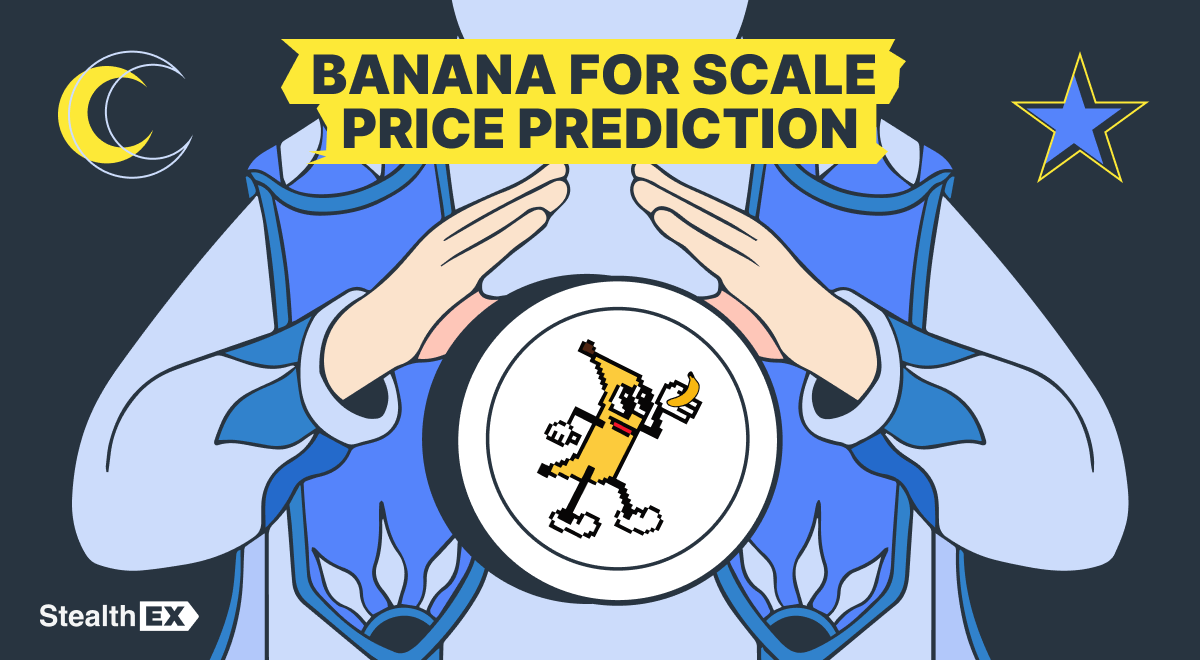 Banana For Scale Price Prediction: Can BANANAS31 Coin Hit $1?
Banana For Scale Price Prediction: Can BANANAS31 Coin Hit $1? 
